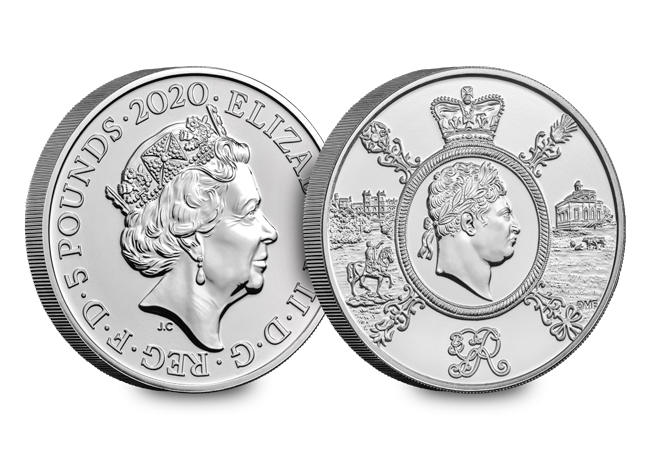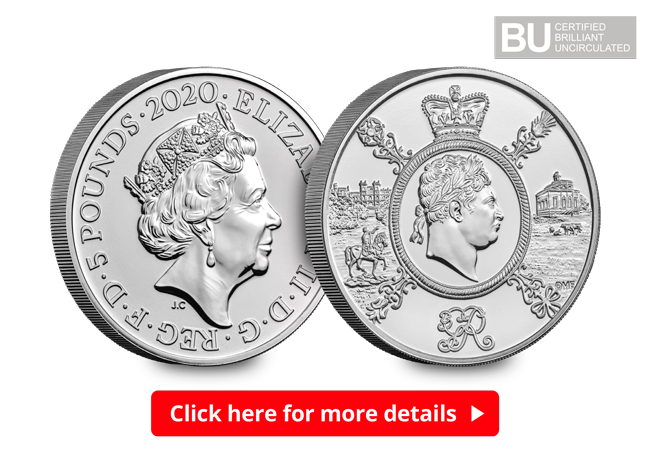Posts Tagged ‘Sovereign’
Queen Victoria – Around the World on Coins…
Cast your imagination back to the 19th century… Queen Victoria ruled 400 million people in an empire that covered almost a quarter of the world’s surface!

With a name and title famous across the globe, it may come as a surprise to you that Queen Victoria never actually stepped foot in many of the countries she ruled over.

India was held with such high regard in Victoria’s heart that it became known as the Jewel in the Empire’s crown. In 1876, India awarded her the title of ‘Empress of India’ in a gesture of appreciation.
Although having never stepped foot in the country and living 4,500 miles away, Victoria’s portrait was minted on to the currency of India (the rupee) from 1840, so people could recognise their empress!
The rupee is one of the oldest currencies in the world, so to feature a British monarch for the first time was an important moment in numismatic history.

The later portrait issued on rupees, similar to the Gothic Head effigy, can be considered one of the most beautiful coins of the empire.

A 22hr flight to Australia seems a long journey now but for Queen Victoria, a trip to this corner of the world would have taken her almost two months to get there!
So, there’s no surprises this was also a country that she never visited. However, the need for a British presence in the country was growing with the empire; as the empire grew, so did the need for coins. The Royal Mint opened branches in Australia and in 1855, a sovereign was minted outside of the UK for the first time – the Sydney sovereign.

It featured a portrait of Victoria that was based on the Young Head effigy, but with a sprig of banksia weaved through Victoria’s hair, giving the portrait a distinct Australian feel.
The Sydney sovereign became incredibly successful and a number of Royal Mint branches were opened throughout Australia as a result. To identify the Mint that sovereigns were produced in, mintmarks were added to the coins, with a small ‘P’ for Perth, and an ‘M’ for Melbourne.

The sovereign became legal tender in the majority of British colonies in the 1860s, and its importance in British trade, and worldwide circulation earned it the title “the King of Coins”. By the final years of the British Empire, the sovereign was minted in four continents across the globe.
India and Australia weren’t the only countries that saw Victoria’s portrait. Her image also reached as far as Hong Kong, Ceylon, East Africa and New Zealand. In 1870 the first Canadian dollar with Victoria’s portrait was issued, taking Victoria’s image to a new side of the world for people to see.
Despite never leaving Europe, Queen Victoria’s portrait and image stood strong on coins around the world. Whilst she never stepped foot in many of the countries that she ruled over, that didn’t stop people recognising her image around the world.
The coins that they used every day provided a link to the empire that they were a part of, despite the miles between them.
If you’ve found this blog informative and have enjoyed reading, let us know in the comments below!
Secure the 2019 UK 200th Anniversary of the Birth of Queen Victoria £5 for your collection!

Your £5 coin has been struck to a superior Brilliant Uncirculated quality and is protectively encapsulated in official Change Checker packaging to ensure that it is preserved for generations.
To secure yours for JUST £10.99 (+p&p) click here >>
George III and the coins celebrating Britain’s longest reigning king
The 2020 George III £5 was issued as part of the Annual Coin Set on the 1st January and today the coin has been individually released.
King George III was the first king of the United Kingdom (which was officially formed in 1800) and to this day remains the longest reigning king in British History, reigning for an astonishing 59 years.
Throughout his reign, Britain fought in wars against France and America and from these wars the country emerged as a world power.
And so, in this anniversary year marking 200 years since his death, it seems only fitting that a brand new United Kingdom George III £5 coin should be issued.
2020 King George III £5 Coin
This is the first time George III has been celebrated on modern UK coinage and the stunning design explores the multifaceted nature of Britain’s longest reigning king.
Designed by renowned Royal Mint designer, Dominique Evans, the famous Bull’s Head portrait of George III is shown in a crowned cartouche, with the royal residence and his place of death, Windsor Palace, to the left and the King’s Observatory, which was founded by King George, to the right.
Click here to secure this coin for your collection!
Our Top Three George III Coins
But of course this is not the first time that King George has featured on UK coinage…
Throughout his reign from 1760 – 1820, the portrait of the king featured on the obverse design of Britain’s circulating coins.
We’ve taken a look at what we feel are three of the most interesting coins issued during his reign and the stories behind them.
1819 Sovereign
The very first gold Sovereign was struck during Henry VII’s reign in 1489, when the king ordered The Royal Mint to produce “A new money of gold.”
Originally Sovereigns were circulating coins accepted in Britain and elsewhere in the world, however it is now a bullion coin and is sometimes mounted in jewellery.
Many recent Sovereigns feature the well-known design of Saint George and the Dragon on the reverse, along with the initials (BP) of the designer, Benedetto Pistrucci.
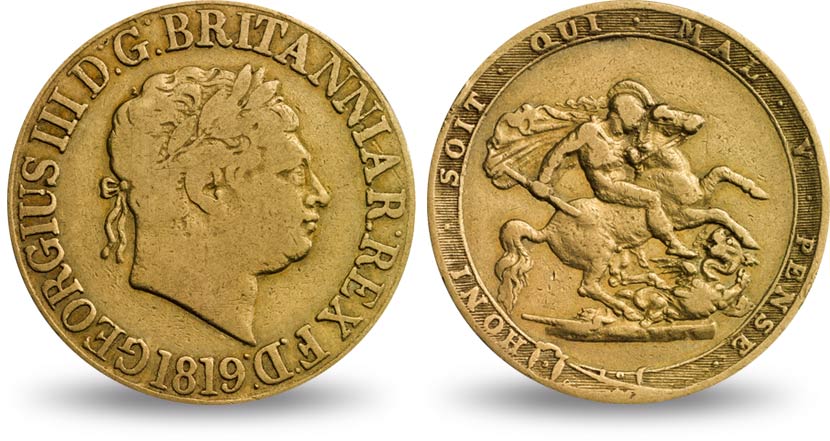
Now you might have heard of the 1819 Sovereigns already, and that’s because these coins are renowned for being exceptionally rare.
Remarkably, only 3,574 Sovereigns were minted during 1819 – struck on five separate occasions, between August and November 1819.
These coins were minted using gold provided by private merchants.
200 years after they were struck, it’s thought that potentially only ten of these Sovereigns are known to still exist.
Unsurprisingly, these coins sell for astonishing prices at auction, with the highest quality 1819 Sovereign known to exist achieving a price of £186,000 in 2013.
Cartwheel Penny
During the 18th century, the practice of melting down official copper coins and making lightweight forgeries had become so widespread that it prompted industrialist Matthew Boulton to offer a solution.
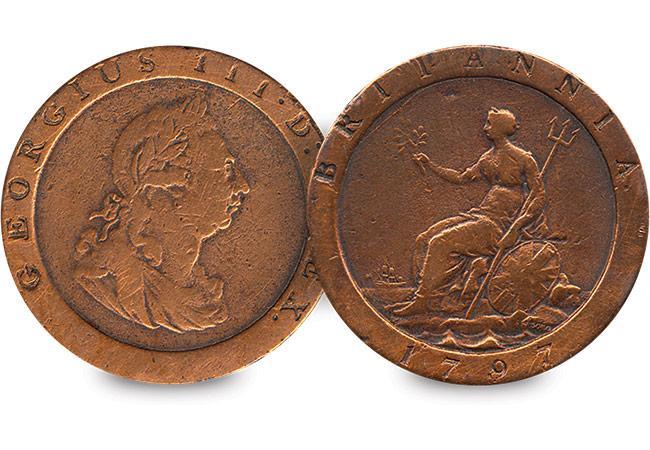
He proposed that each coin should actually be made to contain its value in copper, the quality should be improved by using a retaining collar during striking (to give a perfectly round coin) and thick raised borders would prevent them wearing so easily.
In 1797 Boulton was awarded a contract to supply 480 tonnes of pennies, each weighing one ounce and these were the very first British coins to be minted by steam power.
The George III Cartwheel Penny was also Britannia’s debut appearance on the penny – a position she held until decimalisation in 1971.

Because of their large size, Boulton’s coins soon earned the nickname ‘cartwheels’.
It is highly unusual for a low denomination to have such a substantial size and weight, and unsurprisingly they are in high demand from collectors for their status as Britain’s heaviest ever penny.
Eighteen Pence
In 1797, after a failed French invasion caused financial panic, British gold and silver coins disappeared from circulation, hoarded out of fear.
With so much coinage withdrawn from circulation, The Royal Mint found itself in a vulnerable position with a limited ability to issue coins.
Incredibly, this lead to the extremely unusual situation where the Bank of England acted as a substitute for The Royal Mint by issuing an emergency currency.
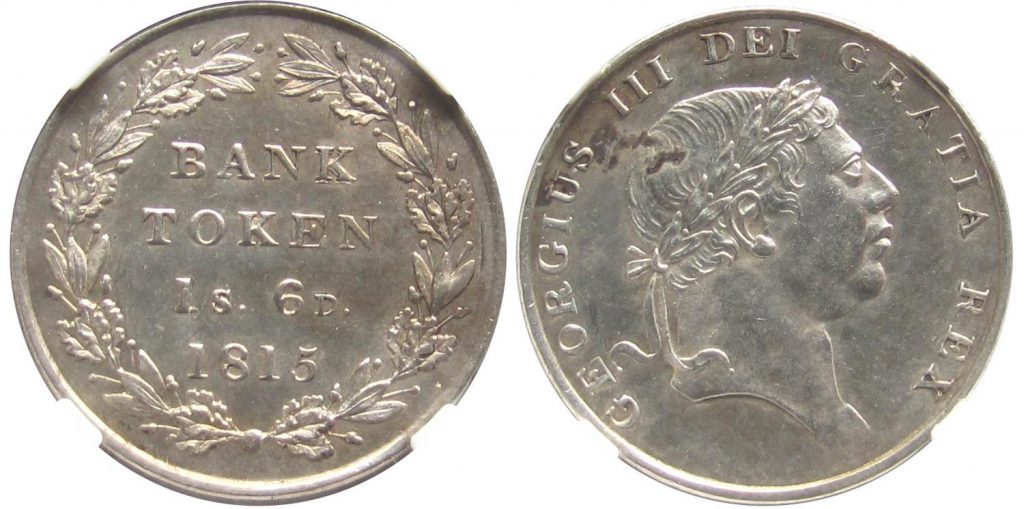
Technically speaking, these emergency issues were not coins but tokens.
This is also the reason why they issued very unusual denominations, including the eighteen pence piece.
These tokens were issued for just 7 years until they were eventually withdrawn from circulation in 1817, by which time a massive silver recoinage had been undertaken.
So now you know the stories behind some of the most acclaimed coins issued during the reign of George III, how does the brand new 2020 £5 coin compare? And will you be adding it to your George III collection?
Secure your 2020 George III £5 Coin
The 2020 George III £5 Coin is now available to purchase individually in superior Brilliant Uncirculated quality.
Victoria, Queen of Coins
Alexandrina Victoria was born on 24th May 1819. At just 18 years old she acceded to the throne and ruled Britain for 63 years, making her Britain’s longest reigning monarch at the time of her death in 1901.
Victoria oversaw the extensive growth and expansion of the British Empire under her rule, with dramatic changes in British culture, industry, and technology. These changes had a significant influence on the development and spread of British coinage.
Victorian currency was minted throughout the world in countries such as India and Australia, as well as Britain. Every coin and portrait tells a unique story – from the ‘Young Head’ which depicted a promising Queen, right through to the ‘Old Head’ which represented an ageing but graceful monarch.
In this blog, we’ll explore the defining coins of Queen Victoria’s reign, as well as taking a look at the modern commemorative coins we see today, issued to celebrate one of Britain’s most influential monarchs.
The defining coins of Queen Victoria’s Reign
1838 Sovereign

The first Sovereign of Queen Victoria’s rule was issued in 1838 with the popular Young Head portrait by William Wyon. The portrait had a particularly youthful look, one that was favoured by Victoria and contributed to the coin’s popularity throughout her reign. To this day, it is the longest a portrait has featured on our circulating coinage, having been issued on bronze coins up until 1895. The Young Head effigy is considered the most favoured portrait of Victoria’s coinage, undergoing only minor changes throughout its lifespan.
Godless Florin

As part of the move towards decimalisation, a coin valued at 1/10th of a pound, the Florin, was introduced in 1849. It featured the Gothic Head portrait by William Wyon which would actually go on to be regarded as one of the most beautiful representations of the Victorian age. However, this coin failed to include the term ‘Dei Gratia’, which earned it the nickname of the Godless Florin. It was swiftly withdrawn from circulation after three years.
Gothic Florin

The Gothic Florin was introduced as a replacement to the Godless Florin and contained a very similar design, but this coin included the term ‘Dei Gratia’. This particular portrait represents the revival of Gothic culture across Victorian life and draws its name from the distinct gothic font used for the inscription around the edge, and the intricate detail on the crown that Victoria wears, which is considered a numismatic masterpiece. As the second Florin to promote decimalisation, the Gothic Florin again failed to gain popularity but was minted for longer than its predecessor.
Click here to own a genuine Queen Victoria Silver Florin
1855 Sydney Sovereign

As part of British imperial expansion, the Royal Mint opened a branch in Sydney and the first Sovereign was minted there in 1855. It had the word ‘Australia’ printed on the reverse and bore a small ‘S’ mintmark to distinguish it as having been minted in Australia. This portrait was only ever seen on Australian coins, produced exclusively at the Sydney Mint for just 14 years. It depicted a younger queen with a sprig of banksia (an Australia plant) weaved into her hair, which gave it a distinct Australian feel.
Double Florin

The Double Florin, in another move towards decimalisation, was valued at 1/5th of a pound and pictured the Jubilee Head. The coin was only 2mm smaller than the Crown but valued at a Shilling less, making it difficult to distinguish between the two. Issued between 1887 and 1890, it is one of the shortest circulating coins in British history. The coin was famously nicknamed the ‘Barmaid’s Ruin’, as tavern maids mistook the coin for a Crown, causing the tavern to lose money and the maid to lose their job!
1901 Sovereign

The final Sovereign of Queen Victoria’s rule depicted the Old Head portrait by Thomas Brock, showing an elegant Queen in her mourning attire. Victoria’s veil had become integral to her image since the death of her husband in 1861, right up until her final years. This is one of the most famous images of Victoria and features on the final sovereign of her reign, issued in 1901 at the end of the Victorian era and the start of a new century.
Modern commemorative coins
Almost 150 years after the birth of Queen Victoria and 120 years after the initial move towards decimalisation, the first decimal coins entered circulation in Britain. The 5p and 10p coins were released in 1968, followed by the 50p coin in 1969.
From the modern coinage we see today, two commemorative £5 coins have been issued in Queen Victoria’s honour.
Death of Queen Victoria 100th anniversary

The death of Queen Victoria in January 1901 marked the end of an era which has left its mark on the modern world. Her reign was remarkable for the extraordinary progress in industry, technology, arts and sciences and the expansion of the British Empire. This coin was issued to mark 100 years since her death and the end of the Victorian era. The reverse by Mary Milner-Dickens reproduces the profile of Victoria by William Wyon against the background of the Crystal Palace exhibition of 1851.
Birth of Queen Victoria 200th anniversary

Under Queen Victoria’s reign, The British Empire became a superpower during an era of peace and prosperity. Designed by John Bergdahl, the reverse of this coin, issued to celebrate the 200th anniversary of the birth of Queen Victoria, features a portrait of Queen Victoria with the dates 1819 – 2019 alongside a steam train, large sailing ship, telephone, and penny farthing. Each element appears in a mechanical circle to represent the incredible inventions of the Victorian period.
Of all the monarchs, Victoria’s reign seems to have captured the imagination of the public more than any other. The coins issued throughout her reign and into the modern age reflect her extraordinary life and rule.
Celebrate the 200th Anniversary of the birth of Queen Victoria
This brand new UK £5 coin has been struck to a superior Brilliant Uncirculated quality and is protectively encapsulated in official Change Checker packaging to ensure that it is preserved for generations.

